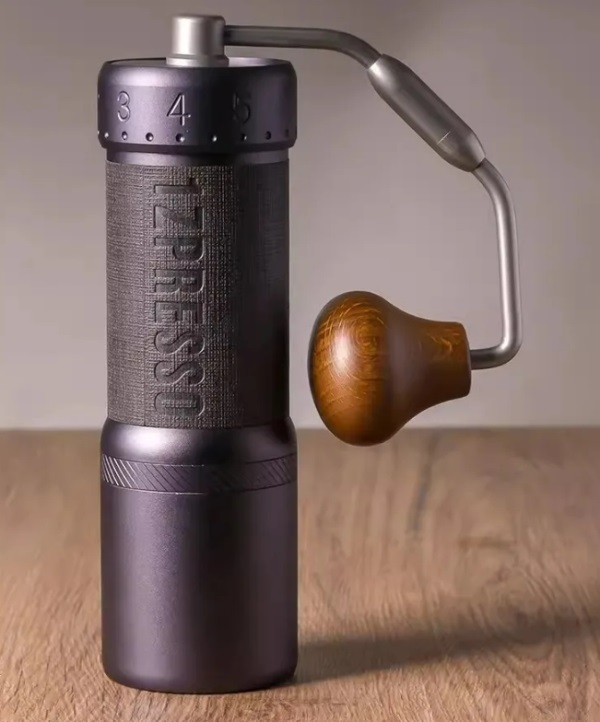The Ultimate Grinding Friend: 1Zpresso J-Ultra Coffee Mill
The Ultimate Grinding Friend: 1Zpresso J-Ultra Coffee Mill
Blog Article
Master the Art of Grinding Coffee Beans: A Guide to Coffee Grinders
For coffee lovers, the procedure of grinding coffee beans is more than just a routine job; it is an art type that can significantly influence the taste and high quality of the last brew. Comprehending the nuances of different mill types, choosing the ideal grind dimension, and using the right techniques are vital steps in the direction of attaining that best mug of coffee.
Sorts Of Coffee Grinders
There are 3 main sorts of coffee mills commonly made use of by coffee fanatics: blade mills, burr grinders, and hand-operated mills. Blade grinders are the many standard type, utilizing a basic blade to cut the coffee beans. While they are affordable and easy to make use of, they typically cause irregular coffee grounds due to inconsistent grinding. Burr grinders, on the other hand, provide more accuracy by crushing the beans between a moving grinding wheel and a non-moving surface. This leads to an uniform grind dimension, which is crucial for a consistent coffee flavor. Burr grinders come in both level and cone-shaped shapes, each offering slightly different grinding characteristics.
Hand-operated grinders, as the name suggests, need hand-operated effort to grind the coffee beans. Each type of coffee mill has its advantages and ideal use cases, catering to the diverse preferences of coffee lovers.

Selecting the Right Work Size
With an understanding of the various types of coffee grinders, the next important action in attaining the excellent cup of coffee is picking the appropriate work dimension. The work dimension plays a considerable function in identifying the taste account of your coffee (1Zpresso J-Ultra). Various brewing methods require specific grind dimensions to maximize the extraction of tastes from the coffee grounds
For a coarse grind, suitable for French press and chilly mixture methods, the coffee beans ought to look like breadcrumbs, providing a durable and bold taste. Medium-coarse grinds, suitable for Chemex or Clever Dripper, have a texture comparable to rugged sand, offering a balanced preference.
Medium grinds, commonly made use of in drip coffee machine, have an uniformity appearing like routine sand, causing a well-rounded flavor. Great grinds, ideal for espresso makers, are akin to common salt, producing a rich and extreme preference. Ultimately, extra-fine grinds, utilized in Turkish coffee, are as great as powdered sugar and generate a strong and powerful brew.
Grinding Techniques for Optimal Taste
To draw out the maximum possibility of flavor from your coffee beans, mastering correct grinding techniques is necessary. Uniformity is essential when it comes to grinding coffee beans for optimum flavor. Making certain that the coffee beans are ground uniformly is important to achieve a balanced removal important link throughout the brewing process. One of the fundamental techniques for enhancing taste is to readjust the grind size based on the brewing approach being made use of. A fine work is optimal for coffee machines, while a crude work is much more appropriate for French press brewing. Additionally, the grinding time plays a significant function in flavor removal. Over-grinding can bring about a bitter preference, while under-grinding might result in a sour flavor. It is suggested to explore various work sizes and brewing times to find the excellent balance that suits your preference choices. By paying focus to these grinding methods, you can raise the taste profile of your coffee and delight in a much more satisfying mug whenever.
Maintenance and Cleaning Up Tips

Along with normal cleansing, it is important to inspect your mill for any signs of wear or damages. Check the blades, burrs, and other elements for any kind of dullness or malfunctions. Replace any worn-out parts immediately to keep the quality of your coffee work. Store your mill in a completely dry and clean atmosphere to protect against any wetness or dirt from affecting its performance. By complying with these upkeep and cleaning suggestions, you can make sure that your coffee mill proceeds to supply delicious newly ground coffee for several years to find.
Troubleshooting Common Grinder Issues


Ensuring your coffee mill works smoothly calls for skilled troubleshooting of typical issues that might occur during its usage. One typical problem with coffee mills is inconsistent work size.
This can occur when oils from the coffee beans build up and block the mill's chute. To solve this, disassemble the grinder and tidy all parts extensively, paying special important link focus to the chute and burrs.
Lastly, if your mill is producing extreme sound during procedure, Look At This it could suggest a trouble with the motor or inner components. In such situations, it is advisable to get in touch with the producer's guidelines for troubleshooting steps or look for professional help to detect and correct the problem promptly.
Final Thought
In verdict, mastering the art of grinding coffee beans involves comprehending the various kinds of coffee mills, choosing the ideal work dimension, using proper grinding methods for optimal taste, and keeping and cleansing the grinder on a regular basis. By adhering to these guidelines and fixing common mill problems, coffee lovers can raise their coffee developing experience and enjoy a scrumptious cup of coffee each time.
Report this page